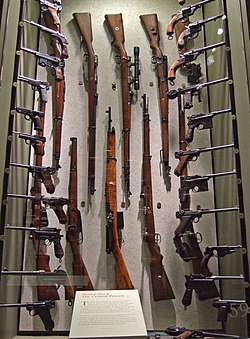
Best known as the first semiautomatic service rifle adopted by a mainstream military force, the 1908 Mondragon was designed by Mexican native Manuel Mondragon, manufactured by SIG in Switzerland, and adopted by the Mexican Army (Ejercito Mexicano). The adoption was short lived, however, as the guns proved unreliable with the low-quality 7mm Mauser ammunition made in Mexico at the time (although they ran fine with high-quality European ammo).
After a partial delivery, Mexico refused to pay for or accept delivery of more, and this left SIG in an awkward position. They would try to sell the rifles for several year, including an attempt to market them to Germany during WWI as aviators’ rifles, with detachable magazines and brass-catching bags. No significant purchases resulted, though.
In this video I will examine 4 different examples of the Mondragon:
- A prototype 1900 model self-loader, which uses the 1908-style action but with en bloc clips instead of stripper clips
- A Mexican-issue 1908, complete with bipod and spade bayonet
- A 1908 rebarreled in 8mm Mauser and send to Germany during WWI
- A standard 1908 updated by SIG and never sold

World War I German service
[edit]
Variety of WWI German rifles and pistols. The Mondragón is the center most rifle
In 1915, the German Empire bought the remainder of the M1908 model rifles produced by SIG[1] (as many as 4000 units, depending on the total SIG production for their Mexican contract). The Germans tried to modify the rifles to chamber the 7.9×57mm S-Patrone, the service cartridge of Germany until the end of World War II, but their attempts were unsuccessful.[17] The rifles were tested by the German Army, but they proved highly susceptible to fouling caused by mud and dirt in the trenches, a common problem even with less complex designs such as the Canadian Ross Mk III straight-pull bolt-action rifle.[18]
The Imperial German Flying Corps (Luftstreitkräfte) decided to adopt the rifle, where operating conditions lessened the chances of the action being fouled by mud, and issued two rifles to each aircraft’s crew. The M1903 proved to be a significant improvement over the bolt-action Gewehr 98 rifles and Parabellum-Pistole pistols usually issued to crews. The M1908 rifle was re-designated as the Fl.-S.-K. 15 (Flieger-Selbstladekarabiner, Modell 1915 - Aviator’s Selfloading Carbine, Model 1915) and was issued with 30-round drum magazines.[1] The drum magazine issued with the Fl.-S.-K. 15 was that designed and patented by Friedrich Blum,[19][20] with a later 32-round version of the drum magazine (Trommelmagazin 08) that had been designed for the 1913 Parabellum-Pistole (LP 08). The corps used the Mondragón rifle until a sufficient number of machine guns equipped with a synchronization gear became available, after which the M1908 was phased out of service and given to the navy. Very few of the Mondragón rifles survived the war,[1] although almost all of the rifles were still in use by the Imperial German Navy when the First World War ended. The usage of the Mondragón in the German Imperial Navy would involve destroyer crews and Seabattlions Pioneers being entirely issued Mondragón and pistol carbines[21] In Switzerland, the Mondragón self-loading rifle was modified to use the 7.5×55mm Swiss cartridge, came equipped with a 12-round magazine and a Hülsenfangkorb (a device to collect the ejected cartridges).
The Mondragón rifle was also briefly installed in the World War I era two-seater aircraft, the Häfeli DH and the Blériot, however it was soon replaced by fully automatic weapons.
These look like 5/10 round guns depending if the drum is really 20 rounds, good guns that could give Germany more semi auto options. The smaller clip could add an option to br 2/3 depending how many rounds are in the magazine. the larger magazine could fill br 3/4 depending on how big its own magazine and how long the loading time is. Germany only has one br2 semi auto while russia has two more dakka more boom. The mondragon with ten rounds could have a longer reload procedure then g43 but quicker then g41 allowing it to fit at br3 without outshining the garand.

